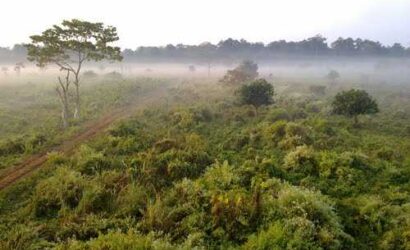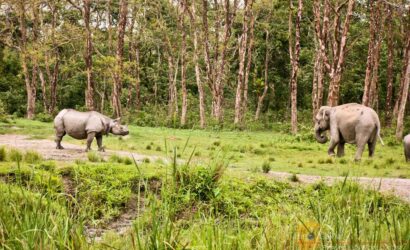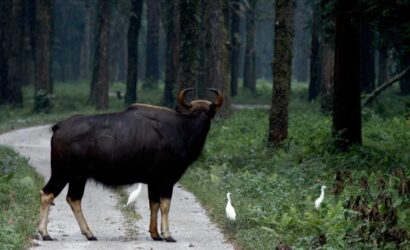Buxa Tiger Reserve, which borders Bhutan and Assam and is located in the northeastern part of West Bengal, was established on February 16, 1983, making it the nation’s fifteenth tiger reserve at the time. The Dooars, Northeast India’s alluvial floodplains, are home to the largest forest, which makes up the Buxa Tiger Reserve.
This massive 759 sq. km. tiger reserve is watered by a number of rivers and their tributaries. It boasts a stunning and varied scenery. In fact, several areas of the forest in the Sinchula Range’s Buxa hills are inaccessible even to the government due to the rugged terrain, and have thus remained untouched for so long!
This tiger reserve’s role as an international passageway for elephant migration between India and Bhutan is another fascinating fact! Due to the proximity of the Phipsu Wildlife Sanctuary in Bhutan to the northern region of the Buxa Tiger Reserve, this is the case.
Buxa National Park
Buxa Tiger Reserve has more than eight different types of forests and is home to 230 species of unidentifiable birds, 67 species of animals, and 36 species of reptiles. This reserve has the second-highest diversity of mammals out of all the tiger reserves in India.
For botany enthusiasts visiting the North Bengal region, Buxa National Park in the Dooars is a must-visit location because of its impressive variety of medicinal plants and rare orchids.
Among all the Indian tiger reserves, Buxa Tiger Reserve has the second-highest diversity of animals. In addition to the Bengal Tiger, Buxa National Park is home to many other magnificent wild animals, including the leopard, wild dogs, Malayan Giant Squirrels, Monkeys, Asian elephants, Gaur, Hog Deer, and Wild Buffalo, as well as three different types of pythons, monitor lizards, and various species of land tortoises.
The best way to see all of this beautiful wildlife is to go on a safari in the Buxa Tiger Reserve. One of the well-known tourist attractions of Buxa National Park is the safari through the Buxa Tiger Reserve.
Tourist Destinations in Buxa National Park
Buxa Fort
A well-known tourist destination in the Dooars region is Buxa Fort, one of the oldest forts in Eastern India. On the Sinchula Range of the Eastern Himalayas, at an elevation of 867 meters, stands the historic fort of Buxa. One of the must-see attractions in Buxa Tiger Reserve is Buxa Fort.
Buxa Fort is nevertheless considered a National Heritage Site despite the fact that just the ruins are left. Since the British imprisoned numerous freedom fighters here, including Netaji Subhash Chandra Bose, many patriotic Indians flock to the Dooars to see Buxa Fort.
Jayanti
This stunning location offers all the serenity and tranquility that are sorely lacking in the hectic pace of our urban lives. It is situated beside the Jayanti River, which naturally creates a boundary with the Bhutan highlands.
Another popular tourist destination in Buxa National Park is Jayanti. Even though the Jayanti River is largely dry, the white pebbles on its banks add to the enduring beauty that never ceases to astound visitors to the Buxa Tiger Reserve.
It is an incredible experience to go through the deep subtropical forest of Buxa Tiger Reserve to reach Jayanti. One of the main tourist destinations in the Dooars Region is the path that leads to Jayanti. The most frequent sights encountered on the Jayanti route are an elephant herd, several peacocks, and barking deer.
There are several locations close to Jayanti that are worth visiting in addition to basking in the natural beauty and bathing in the cold river stream. Pokhari Hill, which is around 4 km from Jayanti, is a must-see tourist attraction in Jayanti. Pokhari Hill is a location of religious worship for the Bhutanese and other locals due to the presence of a sacred lake there.
Mahakal Cave
Another popular tourist destination in Buxa National Park is Jayanti Mahakal, which is situated alongside the Jayanti River and has a natural border with the hills of Bhutan. It is another well-liked site that can be reached after a 13 km hike from Buxa Tiger Reserve.
Mahakal Cave is a cylinder-shaped cave where Lord Shiva is worshiped. It is a must-see location in Buxa National Park. Mahakal Cave can be reached by hiking through the Buxa region’s lush forests, which are renowned for their outstanding bird sightings. It takes around one hour and a half to walk from Buxa Tiger Reserve to Mahakal Cave.
Nearby to Mahakal Cave are three other caves. All of the caves are decorated with idols of various gods. The idols of the Brahma, Vishnu and Maheshwar can be found in the main cave. While the god Mahakali resides in the third, the idol of Lord Shiva is housed in the second and middle ones.
Mahakal Cave is thought to be exceedingly old, and the Shiva deity inside is self-manifest. During Shivaratri is the ideal time to visit the Mahakal cave. The location is stunning all year round as well, however it should be avoided during the wet season because the cave itself is somewhat inaccessible. Travelers are often in awe of Mahakal’s stunning stalagmite cave.
How To Reach Buxa Tiger Reserve
Visitors can easily go to Buxa Tiger Reserve, which is 23 KM from Alipurduar, by taking a train at Alipurduar Railway Station. They can rent a car from Alipurduar Railway Station to get to Buxa Tiger Reserve.
Accommodation In Buxa National Park
The Buxa Tiger Reserve offers tourists a wide variety of lodging options. On the outskirts of Buxa National Park, West Bengal Forest Department Corporation Ltd (WBFDC) has constructed a Forest Bungalow. One of the most popular lodging options in the Dooars is the Buxa Tiger Reserve Forest Bungalow.




